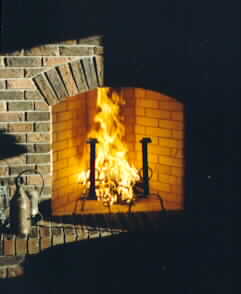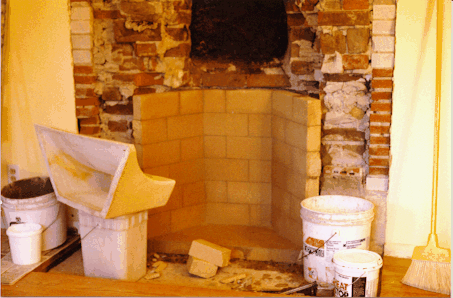
|
Buckley Rumford Fireplaces Refractory Mortar for Masonry Fireplace and Chimney Construction Bob Rucker and Jim Buckley April, 2012
|
| In recent years we have seen vast changes regarding masons' preferred choices of mortar for firebrick (fireplace) and clay flue liner (chimney) installations. Jobsite prepared mortars that may have included fireclay and Portland cement are now out of favor. Factory prepared refractory mortar is now the most widely accepted standard. Refractory mortars have become easier to use, safer, are more readily available, and meet all of the local and national building codes. Masons who resisted them at first now accept them as a better, safer masonry product offering their customers a higher quality installation. No more guesswork regarding homespun mortar formulations, liability issues, or concerns regarding code compliance. And without getting into all of the detail about the fireclay mixes breaking down and losing strength as they pass through the temperature range of 600-800 degrees, they simply don't take the heat like refractory |
mortars do, nor do they have the strength or acid resistance. While our building codes may have been a bit confusing or inconsistent in previous decades, that is no longer the case. The International Code Council (ICC), the International Residential Code (IRC) and the National Fire Protection Association (NFPA-211) now all require refractory mortar tested to American Society for Testing Materials, ASTM C-199, medium duty. Also called out in these codes are the high temperature resistant manufacturing standards for firebrick (ASTM C-27 & C-1261) and for clay flue lining (ASTM C-315). It does make sense that the mortars used for installation of firebrick and clay flues should be manufactured to a high temperature resistant standard as well. After all, what part of residential construction should have more attention to fire safety than that part which we are going to intentionally build a fire in?
|


|
Time for a few questions:
Q: How long does the installation need to set after completion before building a fire?
Q: Where else do you use refractory mortar on your Rumford installations?
Q: What coverage is typically for refractory mortar?
Q: Where can people find all they need to know about a masonry fireplace, chimney, or bread oven?
Q: Any new publications regarding masonry fireplace or chimney construction?
|
Alsey on Refractory Mortar
Whitacre-Greer on Refractory Mortar
Thermal Degradation of Concrete
Comments on Refractory Mortar
Have a comment to make? Click here

Buckley Rumford Fireplaces
Copyright 1995 - 2014 Jim Buckley
All rights reserved.
webmaster

